Related Research Articles

Hatshepsut was the Great Royal Wife of Pharaoh Thutmose II and the fifth Pharaoh of the Eighteenth Dynasty of Egypt, ruling first as regent, then as queen regnant from c. 1479 BC until c. 1458 BC. She was Egypt's second certain queen regnant, the first being Sobekneferu/Nefrusobek in the Twelfth Dynasty.

Thutmose II was the fourth Pharaoh of the Eighteenth Dynasty of Egypt, and his reign is generally dated from 1493 to 1479 BC. Little is known about him and he is overshadowed by his father Thutmose I, half-sister and wife Hatshepsut, and son Thutmose III. He died around the age of 30 and his body was found in the Deir el-Bahri Cache above the Mortuary Temple of Hatshepsut.

Amenhotep I or Amenophis I, was the second Pharaoh of the 18th Dynasty of Egypt. His reign is generally dated from 1526 to 1506 BC.
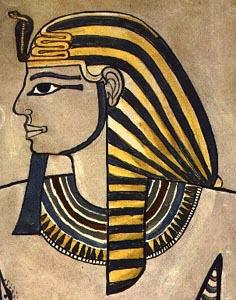
Amenhotep II was the seventh pharaoh of the Eighteenth Dynasty of Egypt. Amenhotep inherited a vast kingdom from his father Thutmose III, and held it by means of a few military campaigns in Syria; however, he fought much less than his father, and his reign saw the effective cessation of hostilities between Egypt and Mitanni, the major kingdoms vying for power in Syria. His reign is usually dated from 1427 to 1401 BC. His consort was Tiaa, who was barred from any prestige until Amenhotep's son, Thutmose IV, came into power.
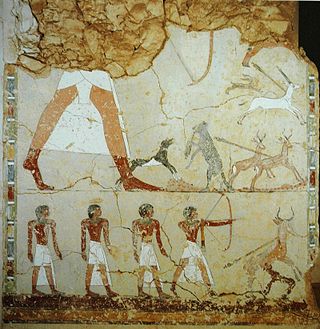
Ineni was an ancient Egyptian architect and government official of the 18th Dynasty, responsible for major construction projects under the pharaohs Amenhotep I, Thutmose I, Thutmose II and the joint reigns of Hatshepsut and Thutmose III. He had many titles, including Superintendent of the Granaries, Superintendent of the Royal Buildings, Superintendent of the Workmen in the Karnak Treasuries, etc.
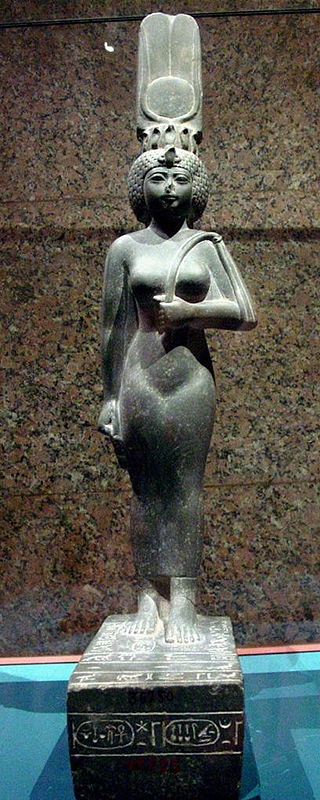
God's Wife of Amun was the highest-ranking priestess of the Amun cult, an important religious institution in ancient Egypt. The cult was centered in Thebes in Upper Egypt during the Twenty-fifth and Twenty-sixth dynasties. The office had political importance as well as religious, since the two were closely related in ancient Egypt.

The necropolis of Sheikh Abd el-Qurna is located on the West Bank at Thebes in Upper Egypt. It is part of the archaeological area of Deir el-Bahari, and named after the domed tomb of the local saint. This is the most frequently visited cemetery on the Theban west bank, with the largest concentration of private tombs.

The necropolis of El-Khokha is located on the west bank of the river Nile at Thebes, Egypt. The necropolis is surrounds a hill and has five Old Kingdom tombs and over 50 tombs from the 18th, 19th and 20th dynasties as well as some from the First Intermediate Period and the Late Period.
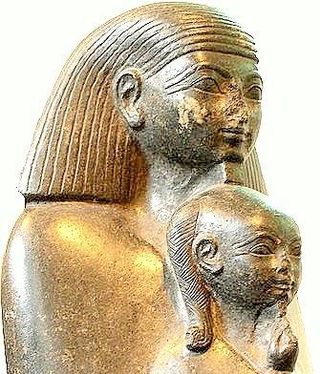
Neferure or Neferura was an Egyptian princess of the Eighteenth Dynasty of Egypt. She was the daughter of two pharaohs, Hatshepsut and Thutmose II. She served in high offices in the government and the religious administration of Ancient Egypt.

Hapuseneb was the High Priest of Amun during the reign of Hatshepsut.

The ancient Egyptian noble Sennefer was "Mayor of the City" and "Overseer of the Granaries and Fields, Gardens and Cattle of Amun" during the reign of Amenhotep II of the Eighteenth Dynasty of Egypt. Being a favourite of the king he accumulated great wealth. He was also allowed to place a double statue of himself and his wife in the temple at Karnak. The famous garden plan, often described as Sennefer's Garden, is more likely to be of a garden which Sennefer managed, and perhaps designed, than to be of a garden which Sennefer owned.
The ancient Egyptian official named Menna carried a number of titles associated with the agricultural estates of the temple of Karnak and the king. Information about Menna comes primarily from his richly decorated tomb in the necropolis of Sheikh Abd al-Qurna at Thebes. Though his tomb has traditionally been dated to the reign of Thutmose IV, stylistic analysis of the decoration places the majority of construction and decoration of the tomb to the reign of Amenhotep III.

Tiaa or Tia'a was an ancient Egyptian queen consort during the Eighteenth Dynasty of Egypt. She was a "faceless concubine" during the time of Amenhotep II who withheld from her the title Great Royal Wife, but when her son Thutmose IV became pharaoh, he performed a revision of her status and gave her that title.
The Treasurer in Ancient Egypt is the modern translation of the title imi-r ḫtmt. The office is known since the end of the Old Kingdom, where people with this title appear sporadically in the organization of private estates.
Amethu called Ahmose was a vizier of ancient Egypt. He served during the reign of Thutmose II and the early years of the reign of Hatshepsut and Thutmose III of the 18th Dynasty.

The Eighteenth Dynasty of Egypt is classified as the first dynasty of the New Kingdom of Egypt, the era in which ancient Egypt achieved the peak of its power. The Eighteenth Dynasty spanned the period from 1550/1549 to 1292 BC. This dynasty is also known as the Thutmosid Dynasty for the four pharaohs named Thutmose.
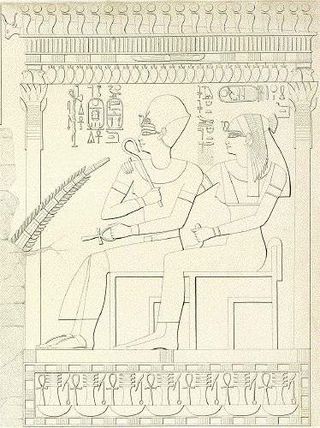
Queen Merytre-Hatshepsut was the Great Royal Wife of Pharaoh Thutmose III after the death of Queen Satiah. She was the mother of Pharaoh Amenhotep II.
The Second Prophet of Amun, also called the Second Priest of Amun, was a high ranking priestly official in the cult of the ancient Egyptian god Amun. The Second Prophet of Amun office was created in the New Kingdom, at the beginning of the Eighteenth Dynasty.
Amenhotep was an ancient Egyptian high steward in office during the reign of Queen Hatshepsut. He is mainly known from his tomb and from a series of rock-cut inscriptions in the Aswan region.
Sememiah was a high ancient Egyptian official of the 18th Dynasty in office under the ruling queen Hatshepsut. His main title was that of an Overseer of the treasuries.
References
- 1 2 Rice, Michael (1999). Who's Who in Ancient Egypt. Routledge. p. 183.
- ↑ JJ Shirley: The Power of the Elite: The Officials of Hatshepsut's Regency and Coregency, in: J. Galán, B. M. Bryan, P. F. Dorman (eds.): Creativity and Innovation in the Reign of Hatshepsut, Studies in Ancient Oriental Civilization 69, Chicago 2014, ISBN 978-1-61491-024-4, p. 230
- ↑ "Senneferi and his family" . Retrieved 2009-05-04.